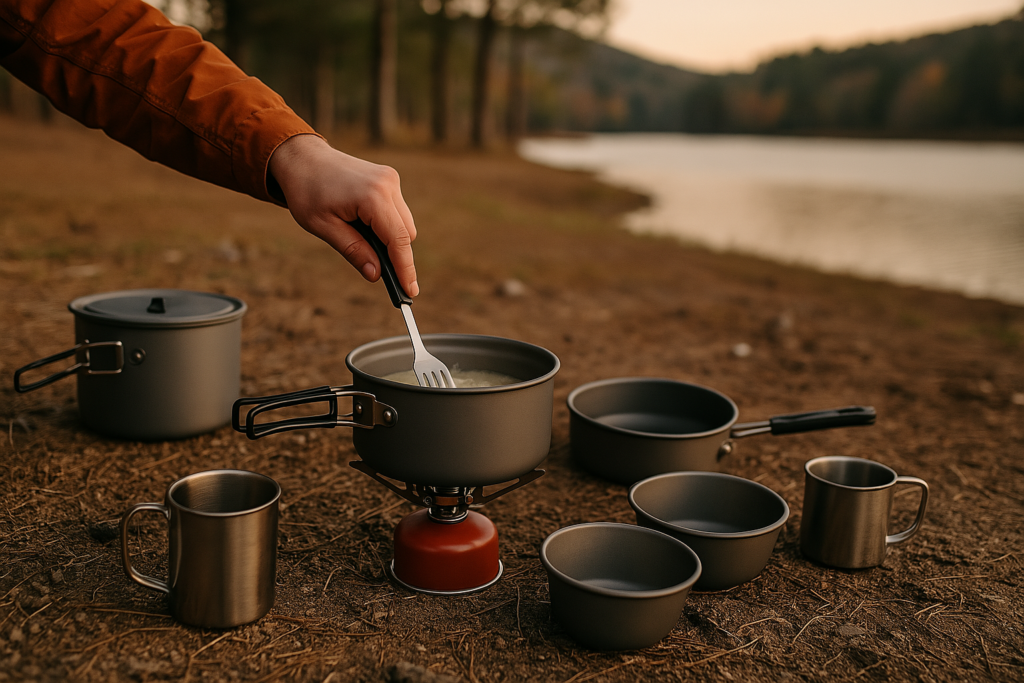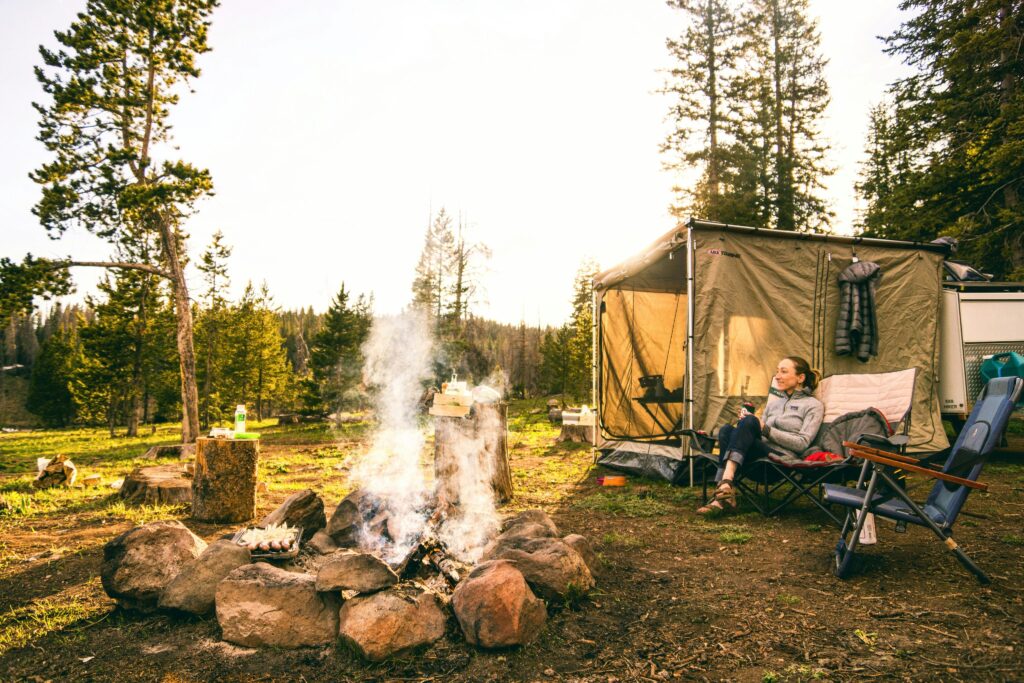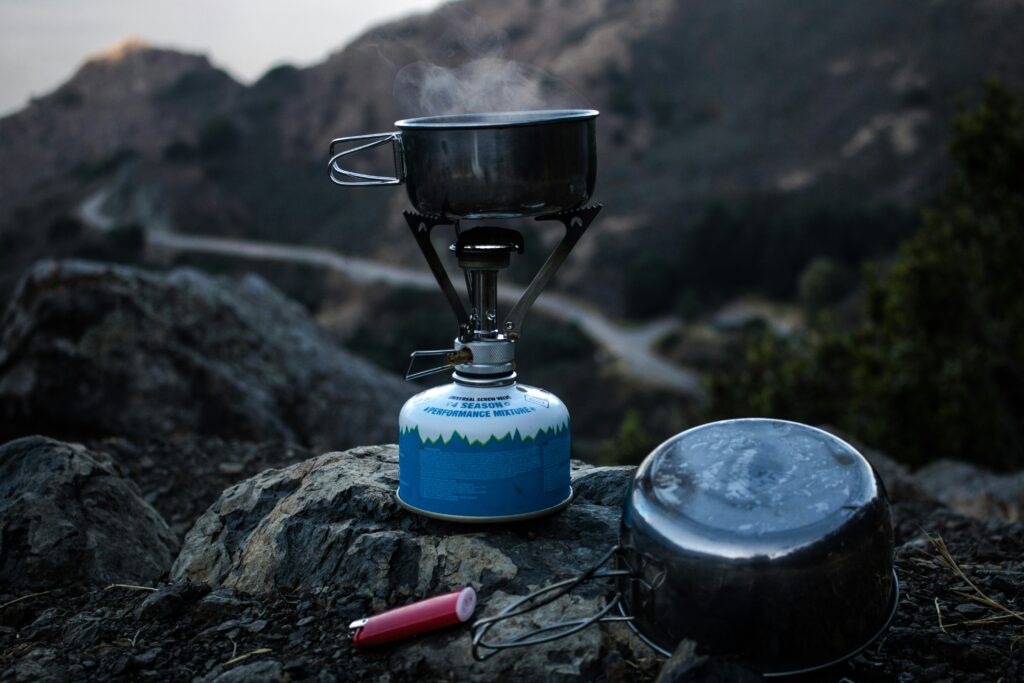Essential Camping Cookware: Must-Have Gear for Your Next Trip
We may earn a commission for purchases made using our links. Please see our disclosure to learn more.
Camping is perhaps one of the greatest ways to get away from the hustle and bustle of daily life, isn’t it? The sound of birds chirping, the crackle of a bonfire, and the fresh air—what’s not to love? Food, however, is one element that might really make or ruin your trip. You want top-notch equipment if you’re cooking in the woods, right? Dealing with broken or subpar cookware is the worst thing that can ruin a fantastic camping trip. Let’s examine the necessary equipment to ensure that your next outdoor supper is a fantastic experience.
Why Camping Cookware is Crucial for Your Trip
Good camping cookware ensures that your meals are safe, tasty, and much easier to prepare; think of it as a secret weapon for making the outdoors feel more like home. “Isn’t camping about hiking, fishing, and sleeping under the stars?” you might ask, and yes, those are all aspects of camping, but let me tell you, food is quite important when you’re out in the bush. A warm lunch feels like the perfect reward after a long day of exploring.
The Essential Camping Cookware Checklist
Alright, let’s kick things off with the basics. What do you really need in your camping cookware set? Here’s a quick list of the essentials:
- Camping Cooking Pots and Pans – These are your workhorses. You’ll need at least one pot and one pan, but if you’ve got room, two is even better.
- Camping Cooking Utensils – A good spatula, tongs, and maybe even a ladle will save you time and hassle.
- Camping Stove – Unless you’re a hardcore fire-cook, a portable stove will be your best friend.
- Camping Plates and Bowls – Eating off of paper plates? Nah, get yourself something reusable.
- Camping Mugs and Cups – You can’t go wrong with a good mug for coffee or hot chocolate around the fire.
- Camping Cutlery Set – Make sure you’ve got forks, knives, and spoons—basic, but super important!

The Best Camping Cookware Materials
Now, let’s talk about the materials your cookware is made from. This might seem like a small detail, but it actually makes a huge difference. You don’t want your cookware to break after a couple of uses, so let’s break down the best options for durability and weight:
- Aluminum – Lightweight and inexpensive, aluminum is the go-to for many campers. It’s perfect for quick meals when you’re on the go.
- Stainless Steel – Tough and rust-resistant, stainless steel is your friend for rugged camping trips. It’s the heavy-duty option.
- Titanium – If you’re one of those backpackers who counts every ounce, titanium is the way to go. It’s lightweight but still super strong.
- Cast Iron – Perfect for those long weekend trips, cast iron holds heat like a champ. If you want that perfect campfire sear, this is your best bet.
Size Matters: Choosing the Right Cookware for Your Group
The main point is that size matters. A solitary traveler will require different cookware than a group of six. If you’re going alone, you’ll want something small and light. However, if you’re cooking for a large group of people, you’ll need a larger pot or multiple pans. Always consider the number of guests and the type of cuisine you intend to serve. Being the one attempting to prepare a large spaghetti dinner in a little pot is the last thing you want. I promise you that’s a disaster waiting to happen.
Multi-Functional Cookware: Space-Saving Ideas
Okay, let’s talk about space. The primary objective of camping equipment is to fit everything you need into a backpack, isn’t that right? Furthermore, cookware can take up a lot of room. Multipurpose equipment is revolutionary because of this. Look for things with several uses, such a pot that doubles as a pan or a kettle that can be used to cook rice. If you have multifunctional equipment, you’ll save weight and room on your trip.
Consider the Weight of Your Cookware
Packing for a hike requires that every ounce counts. If you intend to carry your equipment for kilometers on your back, you should choose cookware that is as light as possible. Heavy cookware is the last thing anyone wants to slow down. The goal is to choose cookware that is durable, lightweight, and useful. You still need to leave room for other essentials, like some food and a cozy sleeping bag!

Non-Stick Cookware: A Blessing or a Curse?
Non-stick cookware is really practical and simplifies life, much like that friend who always brings the greatest munchies. The hitch is that camping isn’t necessarily the best place to use non-stick cookware. If you’re not careful, it can get scratched, especially when using metal utensils. Choose a non-stick product made for outdoor use if you’re going with that option. Additionally, to keep it in great condition, remember to bring some soft utensils!
The Right Camping Stove: A Critical Part of the Gear
If you’re not an expert at starting fires, cooking using a camping stove is pretty much a must. Canister stoves and liquid fuel stoves are the two primary varieties. Canister stoves are small and simple to operate, whereas liquid fuel stoves are ideal for lengthy journeys where you need to carry a lot of fuel. Select the stove that best fits your travel needs and preferences. Whatever you decide, though, be sure it’s dependable enough to get you through every meal without any problems.
Cookware for Cooking Over the Campfire
Cooking over an open fire is a favorite of many. Isn’t that a part of the allure of camping? But you need the correct tools to make it work. For cooking over an open flame, cast-iron skillets, Dutch ovens, and grill grates are ideal. Be aware, however, that cooking over a fire requires a little more experience and patience. However, once you master it, nothing compares to that campfire-smoky flavor.
The Magic of Camping Utensils: Don’t Forget These Tools
When you’re cooking outdoors, the right utensils can make all the difference. Trust me, there’s nothing worse than trying to flip pancakes with a plastic spatula that melts on the first try. A good camping utensil set should include a sturdy spatula, tongs, and a solid knife for cutting and chopping. I also like to bring a multi-tool—because, let’s be real, you never know when you’ll need to open a can or cut a rope.
Insulated Mugs and Cups for Hot Beverages
Nothing beats a hot drink by the campfire, especially on a chilly morning. Insulated mugs and cups are great for keeping your coffee or hot chocolate warm, even if you’re hours away from the nearest kitchen. They’re not just practical, though; they make your camp vibes that much cozier. Just make sure your mug is sturdy enough to survive your rough and tumble outdoor adventures.
Cooking with Convenience: Pre-Packaged Meals vs. Fresh Ingredients
The debate between pre-packaged meals and fresh ingredients is real. Pre-packaged meals are quick, easy, and can save you time. But if you’re a foodie (or just like a good home-cooked meal), bringing fresh ingredients can make all the difference. I suggest bringing a mix of both—some fresh items for your first few meals, and pre-packaged meals for when you’re feeling lazy or need something quick.
Cooking and Cleaning: Don’t Forget Your Cleaning Gear
Let’s face it: no one likes a dirty kitchen, especially not in the great outdoors. Cleaning your cookware might feel like a chore, but trust me, it’s worth it. Pack some eco-friendly soap, a sponge, and maybe even a collapsible sink for easy washing. A clean camp setup not only helps keep pests away, but it’ll make cooking and eating so much more enjoyable.
How to Maintain Your Camping Cookware
Your cookware is an investment, so you’ll want it to last. Don’t just throw it in a pile when you’re done cooking—clean it thoroughly and store it properly. For non-stick cookware, be extra careful with the utensils you use. And, of course, always dry everything before packing it away. With a little love and care, your camping cookware will be good to go for many trips to come.
Budgeting for Camping Cookware: What to Spend and What to Skip
Look, I get it—camping gear can be expensive. But the good news is that you don’t need to break the bank to get decent cookware. The key is striking a balance between price and quality. You don’t have to buy the priciest stuff, but make sure you invest in durable pieces that will last. A few well-chosen items can save you money and make your camping trips more enjoyable in the long run.
Packing Your Camping Cookware: Stay Organized
Packing can be a pain, but a little organization goes a long way. Use stackable containers or mesh bags to keep everything in its place. Some cookware sets even come with their own carrying bags, which can make your life so much easier. The less time you spend digging around for a pot or spoon, the more time you’ll have to relax and enjoy your campsite.

Key Research on Camping Cookware Safety and Market Trends
When considering camping cookware, it’s essential to be aware of the potential health risks associated with certain materials. A study titled “What’s Cooking? PFAS and Other Chemical Hazards in Nonstick Cooking and Baking Pans” by the Ecology Center highlights the dangers of PFAS (per- and polyfluoroalkyl substances), commonly found in nonstick coatings. The report found that a significant portion of tested cookware contained PTFE, a type of PFAS, which may pose serious health risks. This serves as a reminder for campers to carefully consider the materials of their cookware. On a broader scale, a market analysis titled “Outdoor Camping Cookware Market Size & Share Analysis” by Global Growth Insights underscores the increasing demand for durable, multifunctional, and lightweight camping cookware. The study explores how technological innovations have influenced the development of more portable and efficient cooking solutions for outdoor enthusiasts. Both of these sources provide valuable insights into the safety and market evolution of camping cookware, ensuring that campers can make informed decisions when choosing their gear.
Conclusion: Preparing for Your Next Outdoor Feast
Camping cookware isn’t just about having the right gear; it’s about making your camping experience more enjoyable. Whether you’re grilling a steak over the fire or boiling water for your morning coffee, having the right tools makes all the difference. The best part? With a little planning and the right gear, your outdoor meals will be as good as—or even better than—anything you’d cook at home.
FAQs About Camping Cookware
- What’s the most essential piece of camping cookware? A reliable pot and a portable stove are absolute essentials. You can cook pretty much anything with these two!
- Should I go for non-stick cookware for camping? Non-stick cookware is convenient, but it can get scratched easily. It’s perfect for gentle use but be careful when cleaning.
- How do I clean my camping cookware? Pack eco-friendly soap and a sponge to clean your cookware. Always dry it thoroughly before storing.
- Is titanium cookware worth the investment? Absolutely! It’s light, durable, and resistant to rust, which makes it ideal for long hiking trips.
- Can I cook over an open fire? Yes! Cast-iron skillets and Dutch ovens work great over an open flame, but it does take some practice to get it just right.




